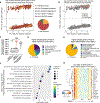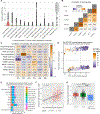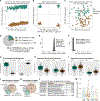Large-scale differentiation of iPSC-derived motor neurons from ALS and control subjects
- PMID: 36764301
- PMCID: PMC10557526
- DOI: 10.1016/j.neuron.2023.01.010
Large-scale differentiation of iPSC-derived motor neurons from ALS and control subjects
Erratum in
-
Large-scale differentiation of iPSC-derived motor neurons from ALS and control subjects.Neuron. 2025 Jun 18;113(12):2028. doi: 10.1016/j.neuron.2025.05.022. Epub 2025 May 28. Neuron. 2025. PMID: 40441139 No abstract available.
Abstract
Using induced pluripotent stem cells (iPSCs) to understand the mechanisms of neurological disease holds great promise; however, there is a lack of well-curated lines from a large array of participants. Answer ALS has generated over 1,000 iPSC lines from control and amyotrophic lateral sclerosis (ALS) patients along with clinical and whole-genome sequencing data. The current report summarizes cell marker and gene expression in motor neuron cultures derived from 92 healthy control and 341 ALS participants using a 32-day differentiation protocol. This is the largest set of iPSCs to be differentiated into motor neurons, and characterization suggests that cell composition and sex are significant sources of variability that need to be carefully controlled for in future studies. These data are reported as a resource for the scientific community that will utilize Answer ALS data for disease modeling using a wider array of omics being made available for these samples.
Keywords: ALS; iPSC; motor neurons; sex differences.
Copyright © 2023 The Authors. Published by Elsevier Inc. All rights reserved.
Conflict of interest statement
Declaration of interests US patent 10,221,395-B2 has been granted describing a method for reprogramming blood to induced pluripotent stem cells. Apart from this issued patent filing, the authors declare that the research was conducted in the absence of any commercial or financial relationships that could be construed as a potential conflict of interest.
Figures





References
-
- Baxi EG, Thompson T, Li J, Kaye JA, Lim RG, Wu J, Ramamoorthy D, Lima L, Vaibhav V, Matlock A, et al. (2022). Answer ALS, a large-scale resource for sporadic and familial ALS combining clinical and multi-omics data from induced pluripotent cell lines. Nat. Neurosci. 25, 226–237. 10.1038/s41593-021-01006-0. - DOI - PMC - PubMed
Publication types
MeSH terms
Grants and funding
LinkOut - more resources
Full Text Sources
Medical
Research Materials
Miscellaneous

